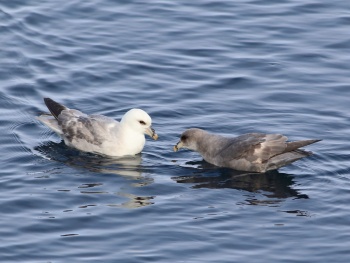- Fulmarus glacialis
Identification
Length 45-51cm. Wingspan 102-112cm.
Atlantic populations
Pale morph: back and rump silvery-grey, upperwings pale grey with darker primaries and carpal area and white bases to primaries forming a pale wing-patch, tail white. Head white with dark lores and underparts white. Underwing white with greyish primary tips and narrow trailing edge. Iris dark brown, short and heavy bill yellowish with bluish-grey base, legs greenish to flesh. Dark morph ("Blue Fulmar"): largely smoky-grey with darker carpal area and promaries but lacks pale patch, plumage wears to brownish; more numerous in subarctic seas. A wide range of intermediates between these two forms occurs.
Pacific populations
Compared to Atlantic populations, differ in greater extremes between palest pale morph and darkest dark morph; upperpart feathering more mottled in appearance with dark speckles. Bill also marginally thinner than Atlantic birds.
Distribution
In the North Pacific breeds on the coasts of eastern Siberia, Sakhalin, the Kurile and Commander Islands, Wrangel, Pribilof and St. Lawrence Islands and the Alaskan Peninsula. In North Atlantic breeds Baffin Island and Greenland, on Svalbard, Bear Island, and Franz Josef Land and perhaps Novaya Zemlya.
Further south breeds in Newfoundland, around the coasts of Iceland, the Faroes and British Isles. Smaller numbers breed on the German island of Heligoland, in Norway and north-west France and has recently bred in Denmark. Range has expanded greatly in Britain over the last century and there are now colonies on much of the east and south coasts where formerly absent.
Pacific birds winter south to Japan and California, rarely Baja California. Atlantic birds disperse from colonies and winter at sea from about 45°N to the Arctic. A few may remain at some colonies throughout the year or visit during non-breeding period but most are at sea during September-March.
Vagrants recorded south to Portugal, Morocco, the Canary Islands, Azores and Madeira, also recorded in Poland and the Czech Republic and in the Mediterranean off Italy and the former Yugoslavia.
Taxonomy
Three subspecies are currently accepted[1]:
- Fulmarus glacialis glacialis – North Atlantic Ocean, northwestern part
- Fulmarus glacialis auduboni – North Atlantic Ocean, southern part
- Fulmarus glacialis rodgersii – North Pacific Ocean
Pacific birds are genetically distinct from Atlantic birds, and have been proposed by some as a full species[5]; conversely, others have suggested that F. g. auduboni should be considered a synonym of F. g. glacialis[4].
Habitat
Breeds on rocky islands and mainland cliffs, sometimes in quarries or among rocks and ruined buildings some distance inland.
Pelagic when not breeding. Often attracted to fishing boats.
Behaviour
Breeding
Breeds in large colonies from mid-May to late September on a bare rock ledge or in a slight depression in softer substrate. Single dull white egg incubated by both sexes for 55-57 days. Young fed by both parents, initially daily but later at longer intervals, leaves nest at 46-51 days.
Very long-lived, with ringed birds well over 50 years known.
Diet
Diet includes squid and fish, also offal from fishing and whaling vessels.
Vocalisation
Voice is a harsh cackling at the nest and when quarrelling for food at sea.
References
- Clements, J. F., T. S. Schulenberg, M. J. Iliff, D. Roberson, T. A. Fredericks, B. L. Sullivan, and C. L. Wood. 2018. The eBird/Clements checklist of birds of the world: v2018. Downloaded from http://www.birds.cornell.edu/clementschecklist/download/
- Carboneras, C., Jutglar, F. & Kirwan, G.M. (2018). Northern Fulmar (Fulmarus glacialis). In: del Hoyo, J., Elliott, A., Sargatal, J., Christie, D.A. & de Juana, E. (eds.). Handbook of the Birds of the World Alive. Lynx Edicions, Barcelona. (retrieved from https://www.hbw.com/node/52514 on 27 August 2018).
- Flood B. and Fischer A. (2016) - North Atlantic Seabirds: Albatrosses and Fulmarine Petrels. Pelagic Birds & Birding Multimedia ID Guides, Scilly.
- Howell, S. N. G. 2012. Petrels, albatrosses, and storm-petrels of North America: A photographic guide. Princeton: Princeton University Press.
- Kerr K.C.R. and Dove C.J. (2013) - Delimiting shades of gray: phylogeography of the Northern Fulmar Fulmarus glacialis. Ecology & Evolution 3: 1915-1930. Published online 2013 May 22. https://doi.org/10.1002/ece3.597
- Mallory, M. L., S. A. Hatch, and D. N. Nettleship (2012). Northern Fulmar (Fulmarus glacialis), version 2.0. In The Birds of North America (A. F. Poole, Editor). Cornell Lab of Ornithology, Ithaca, NY, USA. https://doi.org/10.2173/bna.361
Recommended Citation
- BirdForum Opus contributors. (2025) Northern Fulmar. In: BirdForum, the forum for wild birds and birding. Retrieved 11 May 2025 from https://www.birdforum.net/opus/Northern_Fulmar
External Links
GSearch checked for 2020 platform.1






